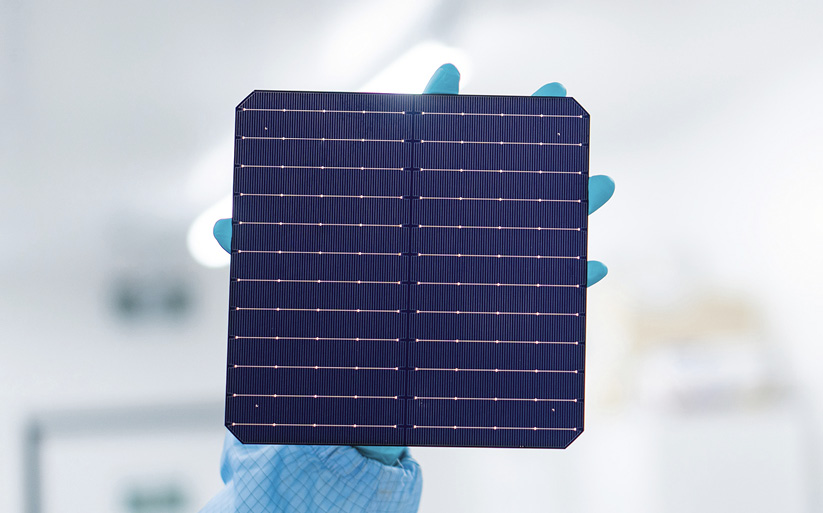Copper plating can more effectively reduce demand for silver. Plated copper is polycrystalline and consequently its conductivity is much greater than either of the cured silver or copper pastes.
It can be argued that, as a material’s reserves are consumed, the mining industry will increase exploration to maintain a constant reserve/production ratio. However, commonly the ore grade in newly discovered reserves declines as the higher quality reserves have already been discovered and mined. The lower quality ore results in increased refining costs and a higher emissions intensity as more energy is required to refine the lower quality ore. Both of these factors will increase the cost of the raw material to the PV manufacturer.
High silver usage is a particular problem for silicon heterojunction (HJT) technology, as HJT bifacial cells currently require around 205 mg per M10 cell, which adds up to roughly 25 tons/GW of silver for 24.5% efficient cells. This silver usage is more than a factor of two greater than used for current passivated emitter and rear contact (PERC) cells and can ultimately limit uptake of HJT technology in manufacturing, despite it being among the most efficient cell technologies available.
One of the main reasons for the high silver usage is that the cells require low temperature silver pastes so as not to damage their surface passivation. These pastes are less conductive; hence a greater mass of silver is required. Low temperature pastes also require long curing times which are undesirable for production. One alternative which is being trialed for HJT cells to reduce metallisation cost is copper pastes. However, to-date the copper particles in these pastes require a thick silver coating to reduce the risk of oxidation, and this coating can comprise up to 50% of the particle by weight. The pastes also offer minimal cost benefits at present due to their limited market experience.
Copper plating can more effectively reduce the demand for silver. Plated copper is polycrystalline and consequently its conductivity is much greater than either of the cured silver or copper pastes. However, unlike pastes which can be screen printed, it is necessary to first form a mask over the transparent conducting oxide (TCO) layer of the SHJ cell before the copper can be plated to the surface of the cell. This masking step adds complexity and cost to the process.
Additionally, many copper plating approaches require that a seed metal layer is first applied by physical vapour deposition to the TCO for increased adhesion of the plated copper and to provide an electrode “clip” contact point during electroplating. This seed layer must be removed after plating, which increases cost and process complexity. Furthermore, the clipping of cells during plating is not compatible with thinner wafers, which are expected to become more common in the near future.
Put theory into practice
Australian startup Sundrive Solar is addressing these challenges with its low-cost masking and direct copper plating processes. The company’s high resolution patterning enables fingers as narrow as 10 microns to be plated directly to the TCO surface of bifacial HJT cells. This process has enabled it to achieve cell efficiencies as high as 26.41% in partnership with Chinese HJT technology equipment provider Suzhou Maxwell Technologies Co, Ltd.
Sundrive’s direct plating process also allows copper plating to low-indium TCOs, which are expected to be required in high volume production to minimize sustainability concerns with regard to limited indium global reserves. Maxwell and Sundrive have achieved an efficiency of 25.94% for a copper-plated cell with a low indium TCO. This demonstrates that it is possible to reduce both silver and indium use in HJT cells without significantly impacting efficiency.
In addition to reducing manufacturing cost, Sundrive’s replacement of 25 tons of silver with 13 tons of copper per GW can reduce the embodied emissions of HJT modules by around 6 kilotons of CO2 equivalents (CO2e) per GW. This reduction is due firstly to the lower mass of copper required per cell; but also the lower emissions intensity of producing copper compared to silver.
Our estimate of reduced embodied emissions by using copper in place of silver for the metallisation of HJT cells is a conservative value because it assumes that all the copper is obtained from primary production. Given that a large fraction of the copper can be resourced from recycling, due to the larger volume of copper in industrial use, the actual embodied emissions of copper plated HJT modules is likely to be even less than our estimated value of 42 t CO2e / GW of HJT cell production. The reduced embodied emissions of copper plated PV modules will ultimately be reflected in a lower module cost.
About the author
Alison Lennon is chief scientist at Australian startup Sundrive Solar and a professor at the School of Photovoltaic and Renewable Energy Engineering at UNSW Sydney, Australia. Her research interests include silicon solar cell metallisation and interconnection and optical and thermomechanical modeling for photovoltaic modules. Since 2010, she has held collaborative research projects at UNSW with Suntech Power, Trina Solar, and LONGi Solar. She was an ARC Future Fellow (2017-21), has published more than 200 scientific papers, and is an inventor of 30 granted US patents.
This content is protected by copyright and may not be reused. If you want to cooperate with us and would like to reuse some of our content, please contact: editors@pv-magazine.com.
